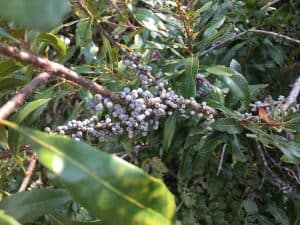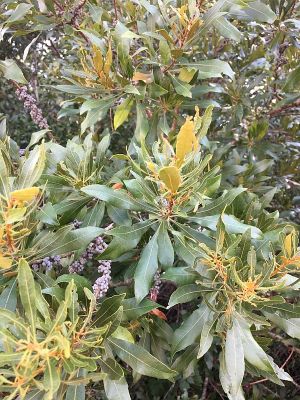
Southern Wax Myrtle- Myrica cerifera
Southern Wax Myrtle is a native evergreen shrub which has been around since before colonial times. Also known as bayberry and candle berry because of its winter holiday fragrance as it’s waxy berries and leaves are still used for candles. This shrub is common in our area and can look attractive in the landscape when grown as a hedge, for screening, as a small multi trunked tree or specimen plant.
Southern wax myrtle attracts wildlife as small rodents/rabbits and birds often use it for cover. Many birds such as myrtle warblers and tree swallows eat the waxy berries for the calories while other birds don’t eat it for the same reasons.
The flowers are inconspicuous and appear in spring followed by berries in Autumn and Winter. Plant both male and female plants for berry production. Only Female plants contain the grey-blue berries which are small and grow in clusters along the stems. The berries are covered in whitish wax.

Bayberry candles were made by early settlers by boiling the leaves and berries. The underside of the plant leaves has resin glands. Wax can still be collected by boiling the berries and crushed leaves of the plant. The wax is skimmed from the top and collected. This plant was also used near the houses of early settlers to keep fleas away.
Southern wax myrtle prefers fertile, moist, acidic soil but is tolerant of a wide range of soils. Southern wax myrtle is a fast grower in full sun and slow grower in shade. Growth can be up to 20 feet by 20-30 feet. Propagation is by seeds and cuttings. Greater success is reported with this shrub when smaller plants are planted. Wax myrtle is a short-lived plant. Pruning is necessary for shaping or to eliminate thick branches. Wood can be brittle. This shrub suckers around the base and close planting around this area should be avoided. Root sprouting can be a problem and will require pruning. This plant has few pests and disease problems if any. I’ve seen some web worms periodically but this can be pruned off. It doesn’t need much fertilizer either, except minimal after the first year of new plantings in spring. Other selections include, ‘Emperor’ which does not grow as fast. ‘Don’s Dwarf’ grows to 5 feet with dense growth.

Submitted by Michelle Gyorgy and Karen Blackburn
